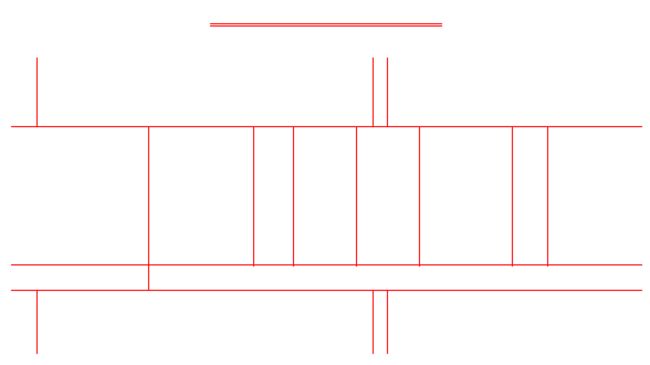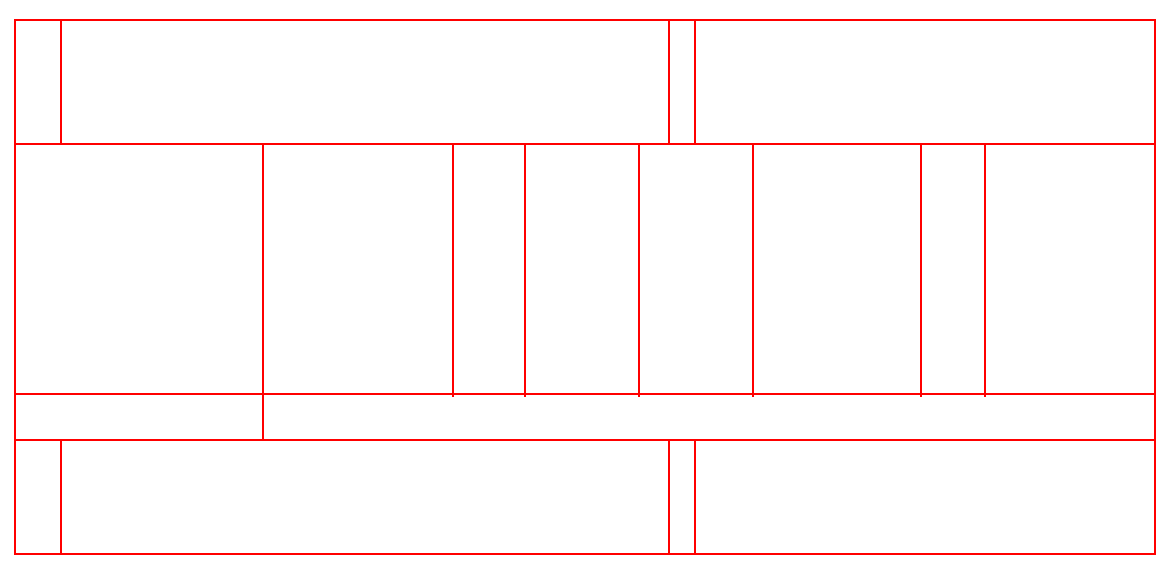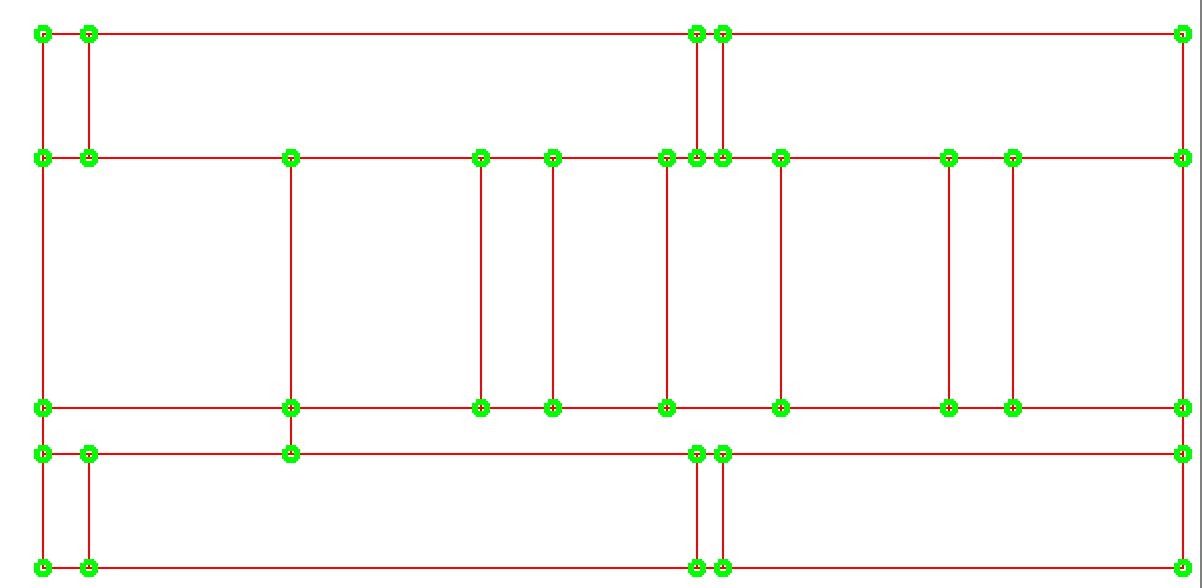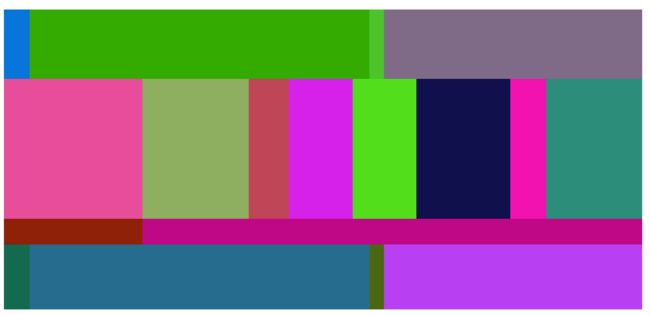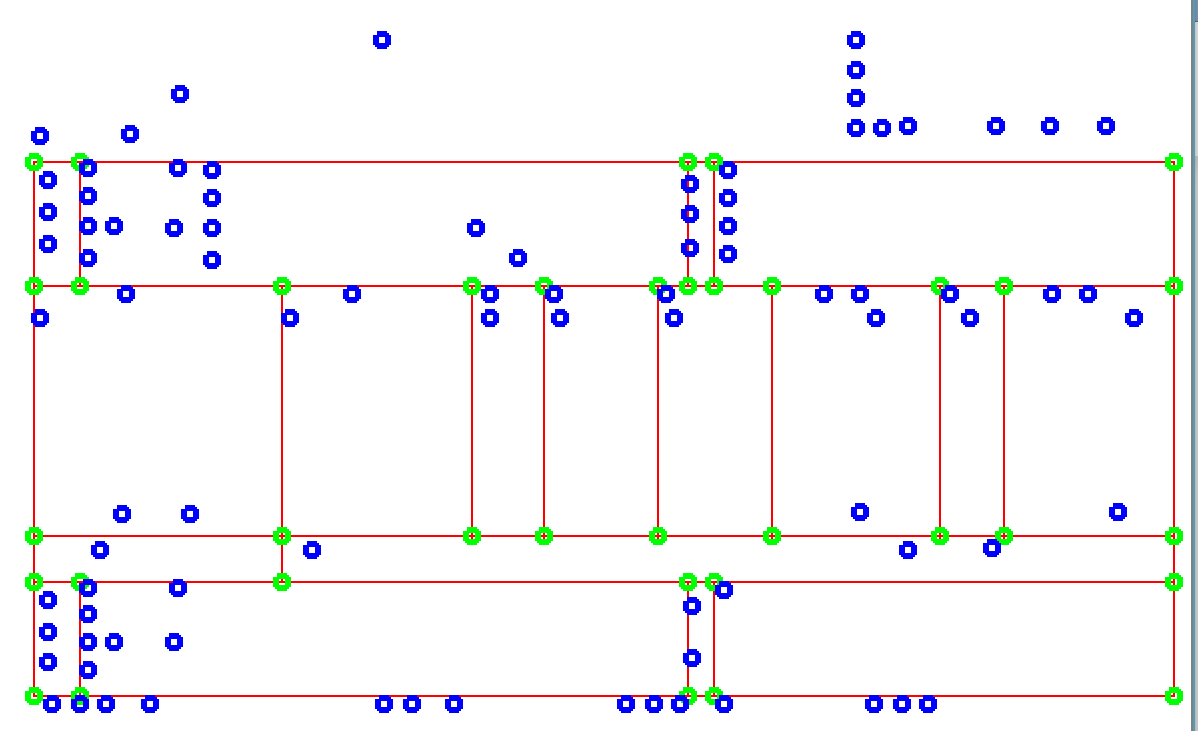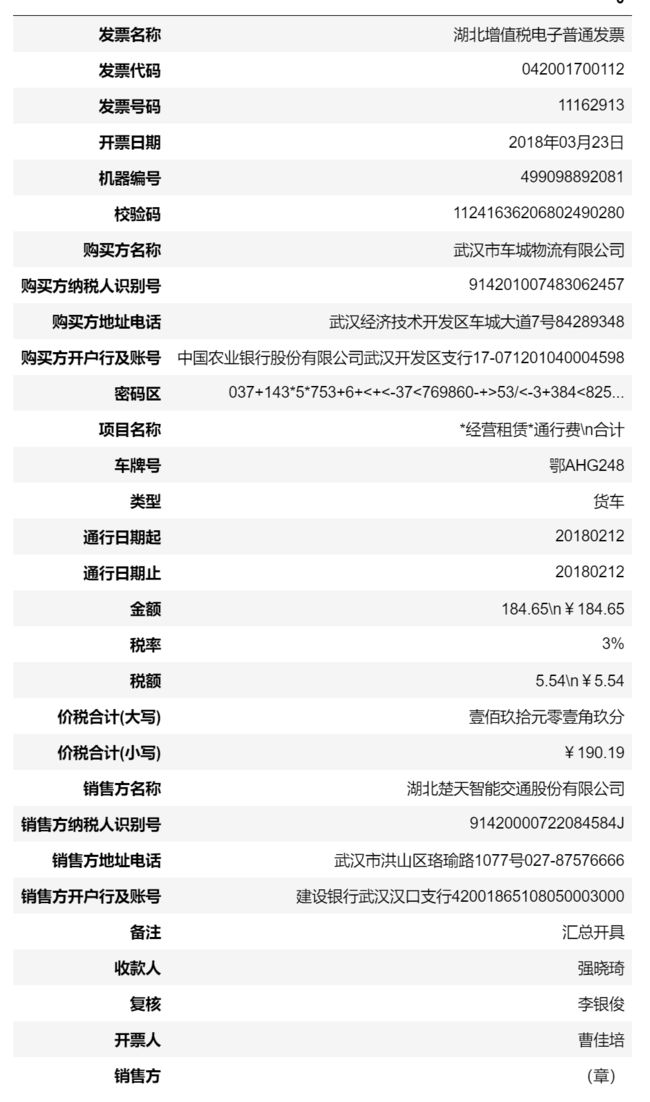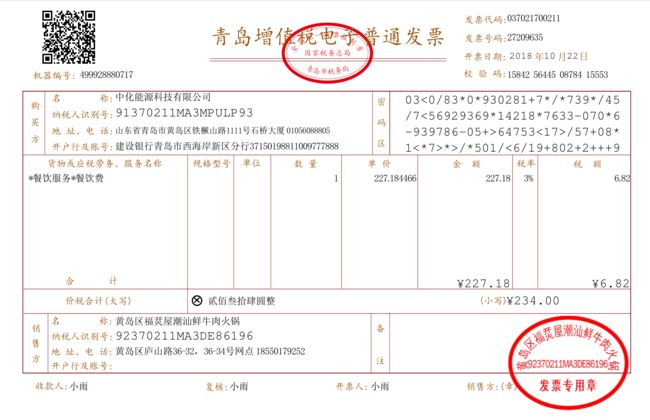PDF电子发票内容提取
原文地址:PDF电子发票内容提取
摘要
本文介绍如何提取PDF版电子发票的内容。
1. 加载内容
首先使用Python的pdfplumber库读入内容。
FILE=r"data/test-2.pdf"
pdf=pb.open(FILE)
page=pdf.pages[0]
接着读取内容并提取线段。
words=page.extract_words(x_tolerance=5)
lines=page.lines # 获取线段(不包括边框线)
for word in words:
print(word)
# 坐标换算
for index,word in enumerate(words):
words[index]["y0"]=word["top"]
words[index]["y1"]=word["bottom"]
for index,line in enumerate(lines):
lines[index]["x1"]=line["x0"]+line["width"]
lines[index]["y0"]=line["top"]
lines[index]["y1"]=line["bottom"]
2. 还原表格
为了将内容划分到合理的位置,需要还原出表格。
首先,把线段分类为横线和竖线,并且剔除较短的两根。
hlines=[line for line in lines if line["width"]>0] # 筛选横线
hlines=sorted(hlines,key=lambda h:h["width"],reverse=True)[:-2] #剔除较短的两根
vlines=[line for line in lines if line["height"]>0] #筛选竖线
vlines=sorted(vlines,key=lambda v:v["y0"]) #按照坐标排列
将线段展示出来如下图。
此时的线段是不闭合的,将缺少的线段补齐得到表格如下。
# 查找边框顶点
hx0=hlines[0]["x0"] # 左侧
hx1=hlines[0]["x1"] # 右侧
vy0=vlines[0]["y0"] # 顶部
vy1=vlines[-1]["y1"] # 底部
thline={"x0":hx0,"y0":vy0,"x1":hx1,"y1":vy0} # 顶部横线
bhline={"x0":hx0,"y0":vy1,"x1":hx1,"y1":vy1} # 底部横线
lvline={"x0":hx0,"y0":vy0,"x1":hx0,"y1":vy1} # 左侧竖线
rvline={"x0":hx1,"y0":vy0,"x1":hx1,"y1":vy1} # 右侧竖线
hlines.insert(0,thline)
hlines.append(bhline)
vlines.insert(0,lvline)
vlines.append(rvline)
接下来,查找所有线段的交点:
# 查找所有交点
points=[]
delta=1
for vline in vlines:
vx0=vline["x0"]
vy0=vline["y0"]
vx1=vline["x1"]
vy1=vline["y1"]
for hline in hlines:
hx0=hline["x0"]
hy0=hline["y0"]
hx1=hline["x1"]
hy1=hline["y1"]
if (hx0-delta)<=vx0<=(hx1+delta) and (vy0-delta)<=hy0<=(vy1+delta):
points.append((int(vx0),int(hy0)))
print('所有交点:',points)
print('交点总计:',len(points))
最后,根据交点构建矩形块
# 构造矩阵
X=sorted(set([int(p[0]) for p in points]))
Y=sorted(set([int(p[1]) for p in points]))
df=pd.DataFrame(index=Y,columns=X)
for p in points:
x,y=int(p[0]),int(p[1])
df.loc[y,x]=1
df=df.fillna(0)
# 寻找矩形
rects=[]
COLS=len(df.columns)-1
ROWS=len(df.index)-1
for row in range(ROWS):
for col in range(COLS):
p0=df.iat[row,col] # 主点:必能构造一个矩阵
cnt=col+1
while cnt<=COLS:
p1=df.iat[row,cnt]
p2=df.iat[row+1,col]
p3=df.iat[row+1,cnt]
if p0 and p1 and p2 and p3:
rects.append(((df.columns[col],df.index[row]),(df.columns[cnt],df.index[row]),(df.columns[col],df.index[row+1]),(df.columns[cnt],df.index[row+1])))
break
else:
cnt+=1
print(len(rects))
for r in rects:
print(r)
3.将单词放入矩形框
首先,在表格中查看一下单词的位置
接下来,将内容放入到矩形框中
# 判断点是否在矩形内
def inRect(point,rect):
px,py=point
p1,p2,p3,p4=rect
if p1[0]<=px<=p2[0] and p1[1]<=py<=p3[1]:
return True
else:
return False
# 将words按照坐标层级放入矩阵中
groups={}
delta=2
for word in words:
p=(int(word["x0"]),int((word["y0"]+word["y1"])/2))
flag=False
for r in rects:
if inRect(p,r):
flag=True
groups[("IN",r[0][1],r)]=groups.get(("IN",r[0][1],r),[])+[word]
break
if not flag:
y_range=[p[1]+x for x in range(delta)]+[p[1]-x for x in range(delta)]
out_ys=[k[1] for k in list(groups.keys()) if k[0]=="OUT"]
flag=False
for y in set(y_range):
if y in out_ys:
v=out_ys[out_ys.index(y)]
groups[("OUT",v)].append(word)
flag=True
break
if not flag:
groups[("OUT",p[1])]=[word]
# 按照y坐标排序
keys=sorted(groups.keys(),key=lambda k:k[1])
for k in keys:
g=groups[k]
print(k,[w["text"] for w in g])
print("*-*-"*20)
4. 结果及代码
最后,提取得到结果:
上图原样本示例:
最后,将代码封装整理为类:
class Extractor(object):
def __init__(self, path):
self.file = path if os.path.isfile else None
def _load_data(self):
if self.file and os.path.splitext(self.file)[1] == '.pdf':
pdf = pb.open(self.file)
page = pdf.pages[0]
words = page.extract_words(x_tolerance=5)
lines = page.lines
# convert coordination
for index, word in enumerate(words):
words[index]['y0'] = word['top']
words[index]['y1'] = word['bottom']
for index, line in enumerate(lines):
lines[index]['x1'] = line['x0']+line['width']
lines[index]['y0'] = line['top']
lines[index]['y1'] = line['bottom']
return {'words': words, 'lines': lines}
else:
print("file %s cann't be opened." % self.file)
return None
def _fill_line(self, lines):
hlines = [line for line in lines if line['width'] > 0] # 筛选横线
hlines = sorted(hlines, key=lambda h: h['width'], reverse=True)[:-2] # 剔除较短的两根
vlines = [line for line in lines if line['height'] > 0] # 筛选竖线
vlines = sorted(vlines, key=lambda v: v['y0']) # 按照坐标排列
# 查找边框顶点
hx0 = hlines[0]['x0'] # 左侧
hx1 = hlines[0]['x1'] # 右侧
vy0 = vlines[0]['y0'] # 顶部
vy1 = vlines[-1]['y1'] # 底部
thline = {'x0': hx0, 'y0': vy0, 'x1': hx1, 'y1': vy0} # 顶部横线
bhline = {'x0': hx0, 'y0': vy1, 'x1': hx1, 'y1': vy1} # 底部横线
lvline = {'x0': hx0, 'y0': vy0, 'x1': hx0, 'y1': vy1} # 左侧竖线
rvline = {'x0': hx1, 'y0': vy0, 'x1': hx1, 'y1': vy1} # 右侧竖线
hlines.insert(0, thline)
hlines.append(bhline)
vlines.insert(0, lvline)
vlines.append(rvline)
return {'hlines': hlines, 'vlines': vlines}
def _is_point_in_rect(self, point, rect):
'''判断点是否在矩形内'''
px, py = point
p1, p2, p3, p4 = rect
if p1[0] <= px <= p2[0] and p1[1] <= py <= p3[1]:
return True
else:
return False
def _find_cross_points(self, hlines, vlines):
points = []
delta = 1
for vline in vlines:
vx0 = vline['x0']
vy0 = vline['y0']
vy1 = vline['y1']
for hline in hlines:
hx0 = hline['x0']
hy0 = hline['y0']
hx1 = hline['x1']
if (hx0-delta) <= vx0 <= (hx1+delta) and (vy0-delta) <= hy0 <= (vy1+delta):
points.append((int(vx0), int(hy0)))
return points
def _find_rects(self, cross_points):
# 构造矩阵
X = sorted(set([int(p[0]) for p in cross_points]))
Y = sorted(set([int(p[1]) for p in cross_points]))
df = pd.DataFrame(index=Y, columns=X)
for p in cross_points:
x, y = int(p[0]), int(p[1])
df.loc[y, x] = 1
df = df.fillna(0)
# 寻找矩形
rects = []
COLS = len(df.columns)-1
ROWS = len(df.index)-1
for row in range(ROWS):
for col in range(COLS):
p0 = df.iat[row, col] # 主点:必能构造一个矩阵
cnt = col+1
while cnt <= COLS:
p1 = df.iat[row, cnt]
p2 = df.iat[row+1, col]
p3 = df.iat[row+1, cnt]
if p0 and p1 and p2 and p3:
rects.append(((df.columns[col], df.index[row]), (df.columns[cnt], df.index[row]), (
df.columns[col], df.index[row+1]), (df.columns[cnt], df.index[row+1])))
break
else:
cnt += 1
return rects
def _put_words_into_rect(self, words, rects):
# 将words按照坐标层级放入矩阵中
groups = {}
delta = 2
for word in words:
p = (int(word['x0']), int((word['y0']+word['y1'])/2))
flag = False
for r in rects:
if self._is_point_in_rect(p, r):
flag = True
groups[('IN', r[0][1], r)] = groups.get(
('IN', r[0][1], r), [])+[word]
break
if not flag:
y_range = [
p[1]+x for x in range(delta)]+[p[1]-x for x in range(delta)]
out_ys = [k[1] for k in list(groups.keys()) if k[0] == 'OUT']
flag = False
for y in set(y_range):
if y in out_ys:
v = out_ys[out_ys.index(y)]
groups[('OUT', v)].append(word)
flag = True
break
if not flag:
groups[('OUT', p[1])] = [word]
return groups
def _find_text_by_same_line(self, group, delta=1):
words = {}
group = sorted(group, key=lambda x: x['x0'])
for w in group:
bottom = int(w['bottom'])
text = w['text']
k1 = [bottom-i for i in range(delta)]
k2 = [bottom+i for i in range(delta)]
k = set(k1+k2)
flag = False
for kk in k:
if kk in words:
words[kk] = words.get(kk, '')+text
flag = True
break
if not flag:
words[bottom] = words.get(bottom, '')+text
return words
def _split_words_into_diff_line(self, groups):
groups2 = {}
for k, g in groups.items():
words = self._find_text_by_same_line(g, 3)
groups2[k] = words
return groups2
def _index_of_y(self, x, rects):
for index, r in enumerate(rects):
if x == r[2][0][0]:
return index+1 if index+1 < len(rects) else None
return None
def _find_outer(self, k, words):
df = pd.DataFrame()
for pos, text in words.items():
if re.search(r'发票$', text): # 发票名称
df.loc[0, '发票名称'] = text
elif re.search(r'发票代码', text): # 发票代码
num = ''.join(re.findall(r'[0-9]+', text))
df.loc[0, '发票代码'] = num
elif re.search(r'发票号码', text): # 发票号码
num = ''.join(re.findall(r'[0-9]+', text))
df.loc[0, '发票号码'] = num
elif re.search(r'开票日期', text): # 开票日期
date = ''.join(re.findall(
r'[0-9]{4}年[0-9]{1,2}月[0-9]{1,2}日', text))
df.loc[0, '开票日期'] = date
elif '机器编号' in text and '校验码' in text: # 校验码
text1 = re.search(r'校验码:\d+', text)[0]
num = ''.join(re.findall(r'[0-9]+', text1))
df.loc[0, '校验码'] = num
text2 = re.search(r'机器编号:\d+', text)[0]
num = ''.join(re.findall(r'[0-9]+', text2))
df.loc[0, '机器编号'] = num
elif '机器编号' in text:
num = ''.join(re.findall(r'[0-9]+', text))
df.loc[0, '机器编号'] = num
elif '校验码' in text:
num = ''.join(re.findall(r'[0-9]+', text))
df.loc[0, '校验码'] = num
elif re.search(r'收款人', text):
items = re.split(r'收款人:|复核:|开票人:|销售方:', text)
items = [item for item in items if re.sub(
r'\s+', '', item) != '']
df.loc[0, '收款人'] = items[0] if items and len(items) > 0 else ''
df.loc[0, '复核'] = items[1] if items and len(items) > 1 else ''
df.loc[0, '开票人'] = items[2] if items and len(items) > 2 else ''
df.loc[0, '销售方'] = items[3] if items and len(items) > 3 else ''
return df
def _find_and_sort_rect_in_same_line(self, y, groups):
same_rects_k = [k for k, v in groups.items() if k[1] == y]
return sorted(same_rects_k, key=lambda x: x[2][0][0])
def _find_inner(self, k, words, groups, groups2, free_zone_flag=False):
df = pd.DataFrame()
sort_words = sorted(words.items(), key=lambda x: x[0])
text = [word for k, word in sort_words]
context = ''.join(text)
if '购买方' in context or '销售方' in context:
y = k[1]
x = k[2][0][0]
same_rects_k = self._find_and_sort_rect_in_same_line(y, groups)
target_index = self._index_of_y(x, same_rects_k)
target_k = same_rects_k[target_index]
group_context = groups2[target_k]
prefix = '购买方' if '购买方' in context else '销售方'
for pos, text in group_context.items():
if '名称' in text:
name = re.sub(r'名称:', '', text)
df.loc[0, prefix+'名称'] = name
elif '纳税人识别号' in text:
tax_man_id = re.sub(r'纳税人识别号:', '', text)
df.loc[0, prefix+'纳税人识别号'] = tax_man_id
elif '地址、电话' in text:
addr = re.sub(r'地址、电话:', '', text)
df.loc[0, prefix+'地址电话'] = addr
elif '开户行及账号' in text:
account = re.sub(r'开户行及账号:', '', text)
df.loc[0, prefix+'开户行及账号'] = account
elif '密码区' in context:
y = k[1]
x = k[2][0][0]
same_rects_k = self._find_and_sort_rect_in_same_line(y, groups)
target_index = self._index_of_y(x, same_rects_k)
target_k = same_rects_k[target_index]
words = groups2[target_k]
context = [v for k, v in words.items()]
context = ''.join(context)
df.loc[0, '密码区'] = context
elif '价税合计' in context:
y = k[1]
x = k[2][0][0]
same_rects_k = self._find_and_sort_rect_in_same_line(y, groups)
target_index = self._index_of_y(x, same_rects_k)
target_k = same_rects_k[target_index]
group_words = groups2[target_k]
group_context = ''.join([w for k, w in group_words.items()])
items = re.split(r'[((]小写[))]', group_context)
b = items[0] if items and len(items) > 0 else ''
s = items[1] if items and len(items) > 1 else ''
df.loc[0, '价税合计(大写)'] = b
df.loc[0, '价税合计(小写)'] = s
elif '备注' in context:
y = k[1]
x = k[2][0][0]
same_rects_k = self._find_and_sort_rect_in_same_line(y, groups)
target_index = self._index_of_y(x, same_rects_k)
if target_index:
target_k = same_rects_k[target_index]
group_words = groups2[target_k]
group_context = ''.join([w for k, w in group_words.items()])
df.loc[0, '备注'] = group_context
else:
df.loc[0, '备注'] = ''
else:
if free_zone_flag:
return df, free_zone_flag
y = k[1]
x = k[2][0][0]
same_rects_k = self._find_and_sort_rect_in_same_line(y, groups)
if len(same_rects_k) == 8:
free_zone_flag = True
for kk in same_rects_k:
yy = kk[1]
xx = kk[2][0][0]
words = groups2[kk]
words = sorted(words.items(), key=lambda x: x[0]) if words and len(
words) > 0 else None
key = words[0][1] if words and len(words) > 0 else None
val = [word[1] for word in words[1:]
] if key and words and len(words) > 1 else ''
val = '\n'.join(val) if val else ''
if key:
df.loc[0, key] = val
return df, free_zone_flag
def extract(self):
data = self._load_data()
words = data['words']
lines = data['lines']
lines = self._fill_line(lines)
hlines = lines['hlines']
vlines = lines['vlines']
cross_points = self._find_cross_points(hlines, vlines)
rects = self._find_rects(cross_points)
word_groups = self._put_words_into_rect(words, rects)
word_groups2 = self._split_words_into_diff_line(word_groups)
df = pd.DataFrame()
free_zone_flag = False
for k, words in word_groups2.items():
if k[0] == 'OUT':
df_item = self._find_outer(k, words)
else:
df_item, free_zone_flag = self._find_inner(
k, words, word_groups, word_groups2, free_zone_flag)
df = pd.concat([df, df_item], axis=1)
return df
if __name__=="__main__":
path=r'data.pdf'
data = Extractor(path).extract()
print(data)
